***Updated to reflect 2024 Fuel Storage Requirements***
Did you know that you can be issued a citation by the Bureau of Land Management if your fuel is stored directly on the playa or too close to your trailer? Yes, it is at the BLM’s discretion to cite you for any fuel storage issues, which would bring law enforcement into your camp, potentially leading to unwelcomed searches. Please help us help you prevent these avoidable interactions. Consider your impact!
This post is part of the Consider Your Impact series
Our community takes its environmental responsibilities seriously, and properly storing fuel is paramount to preventing leaks and protecting the playa. Amazingly, improper fuel storage makes up almost 70% of the LNT issues we come across. Seriously, 70%! Not only is Leaving No Trace one of the 10 Principles and an ethic ingrained in our culture, it is also mandated by the Bureau of Land Management through our event permit.
The photos shown below were taken over the past few years by our LNT Outreach teams, comprised of Earth Guardian and Black Rock Ranger volunteers. These teams cruise around the city looking for any LNT issues and will help you fix them. You have 24 hours to fix a problem before we have to notify BLM. Help us help you NOW as you’re prepping for the Burn by following these five tips for doing it right, so you can leave no trace, and avoid citations!
- Contain your fuel
- Don’t store next to a heat source
- Keep fuel away from RV/trailers and non-fuel items
- Limit fuel stored in camps
- Avoid fuel-vehicle collisions!
- All stored fuel containers, regardless of size or type of fuel (gas, diesel, kerosene), need secondary containment that can hold 110% of the largest container.
1) Contain Your Fuel
Don’t put your fuel cans directly on the playa! Secondary containment can be simple: use storage bins to hold your five gallon cans. For storage of five gallon containers, that’s 5.5 gallons of space needed in case of a leak. Even if the can is empty, put it back in its secondary containment.
Here are photos of excellent secondary containment:
 Secondary containment is this simple! The industry-standard for fuel secondary containment in the photo on the right. The only thing that we’d fix with this to is move the can towards the center of the containment, and move it 10 ft away from non-fuel items.
Secondary containment is this simple! The industry-standard for fuel secondary containment in the photo on the right. The only thing that we’d fix with this to is move the can towards the center of the containment, and move it 10 ft away from non-fuel items.
Here are some examples of what NOT to do:

Even though the fuel is off of the ground, chances are that the truck bed is not completely sealed and fuel leaks could still get on the playa. Fuel can be stored in your truck bed if it has secondary containment or if it is sealed.
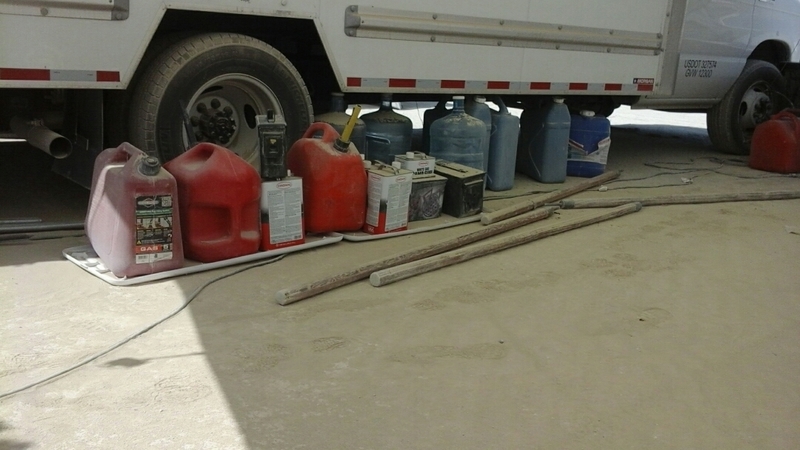
The fuel containers are not directly on the ground, but the lids would not contain any fuel that spills nor is its volume 110% of the largest container (5.5 gallons). Also the fuel needs to be 10 ft away from non-fuel items as well as sources of ignition, like vehicles and trailers.
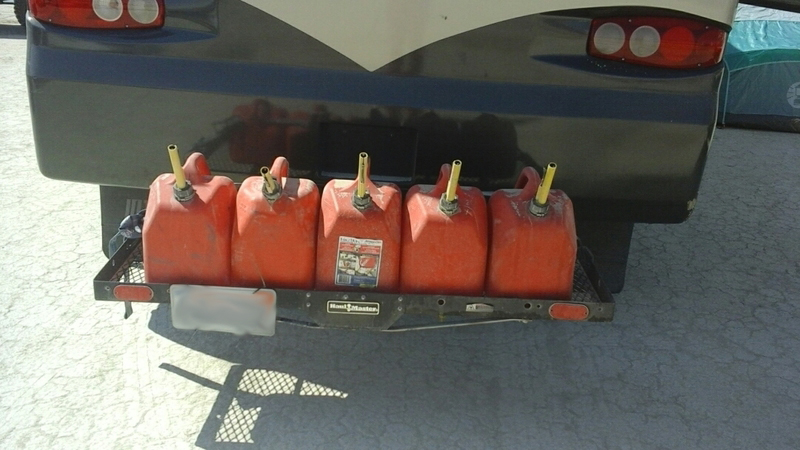
The fuel is off of the ground, yes, but it’s on a mesh gate, is next to an RV, and there’s no secondary containment.
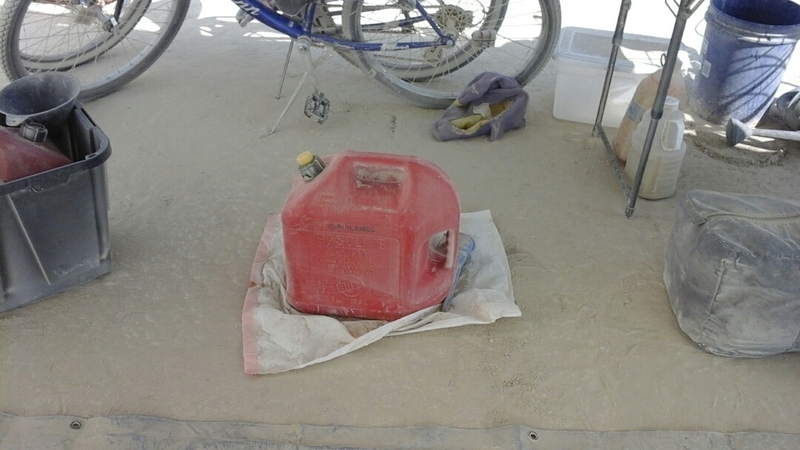
Even if this plastic bag was around the fuel container, plastic bags are never acceptable secondary containment. In addition, plastic bags can cause a spark, which can ignite fuel.
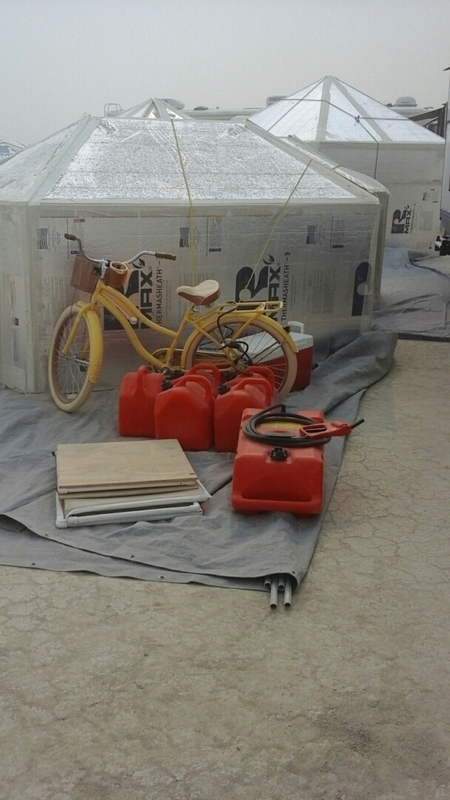
Even if you’re just setting up your camp, place fuel containers in secondary containment immediately. Leaks can happen at any point so please be proactive. Would you want to live in that shelter? The bike tips over, the cans tip over and you have…
2) Do not Store Fuel Next to a Heat Source
Do not store fuel next to generators. Just don’t. Period. We have seen a five-gallon can with gas in it, which burst from pressure built up from the heat of being next to a running generator! Here are examples of doing it wrong:
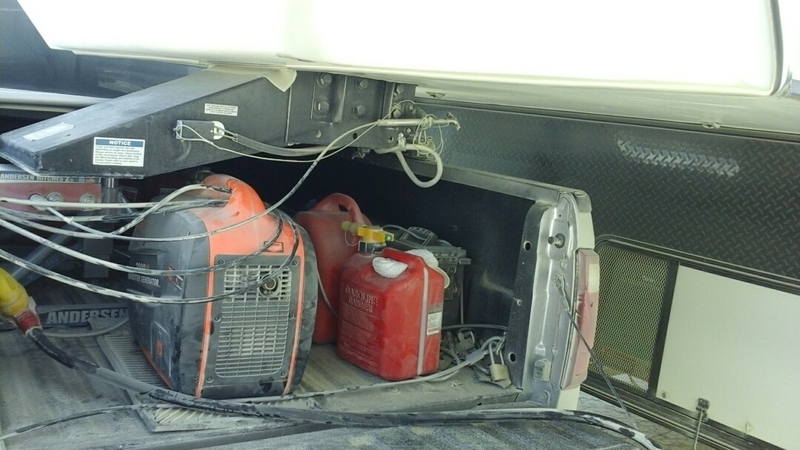
These cans are right next to a generator, under a living space of the trailer above. They are over the fuel tank of the truck and don’t have any secondary containment!
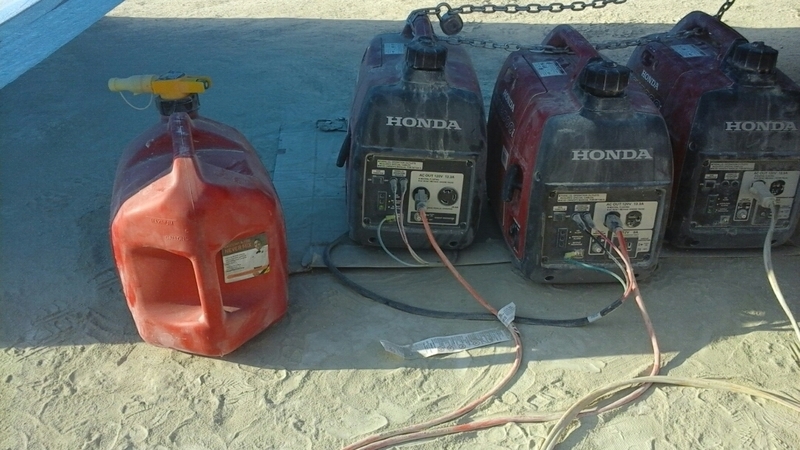
Triple the trouble and with no secondary containment!!!
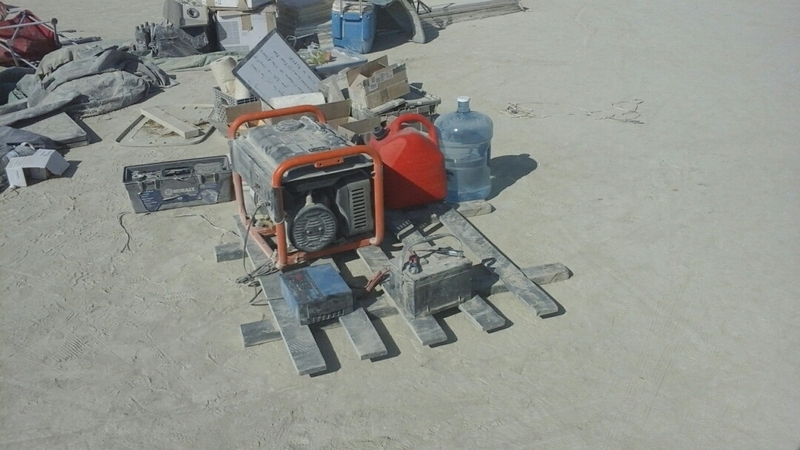
It is good to have generators elevated slightly from the playa but don’t store fuel next to your generator and always have secondary containment for your fuel. We should also feel sorry for the truck rental company whose truck stake sides are being used for this!

Don’t lock your fuel to your generator!! There are many other safer places to securely store fuel that’s not next to a heat source.
3) Do not Store Fuel Under or Next to a Trailer/RV/Tent and Keep Fuel 10 ft Away From Anything Else
Don’t build shade over liquid fuel storage areas. (Shade may be constructed over propane storage areas.) Containers designed to hold fuel can be stored in full sun as long as it is only filled to 80% of its capacity. So don’t overfill your cans — fuel expands with heat — use the fill lines on the container to know where 80% is. And store your fuel in secondary containment 10 ft from anything else.
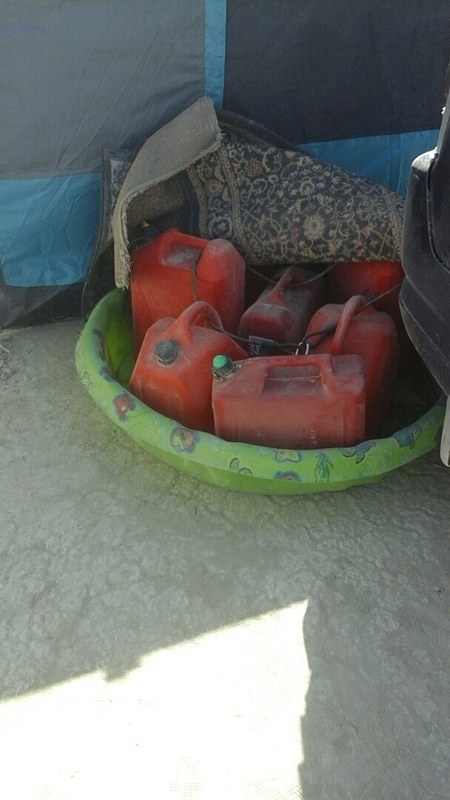
This fuel does have secondary containment, but it is right next to a tent (sigh!), covered partially by a carpet (wick!), and right behind a car (very easy to run over).
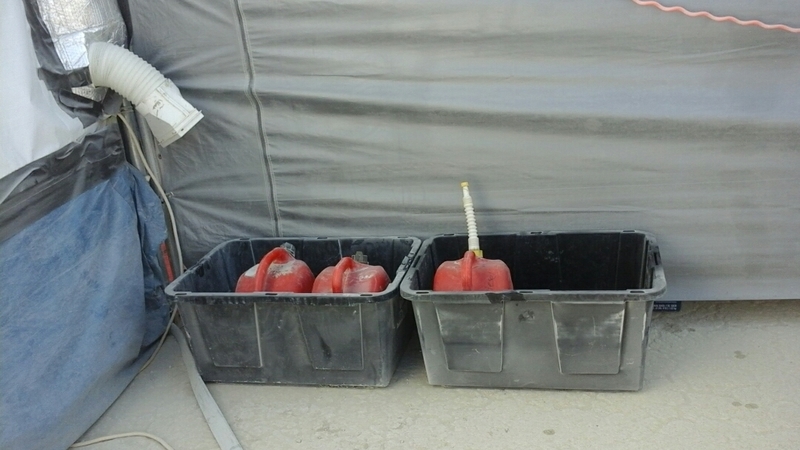
The fuel does have secondary containment; however, it’s right next to a tent and is below an exhaust fan.

These cans are too close to the tent again! Not sure who wants to live in that tent of doom but… Also these cans do not have secondary containment. Oww, and the can in the background has containment that’s too small.
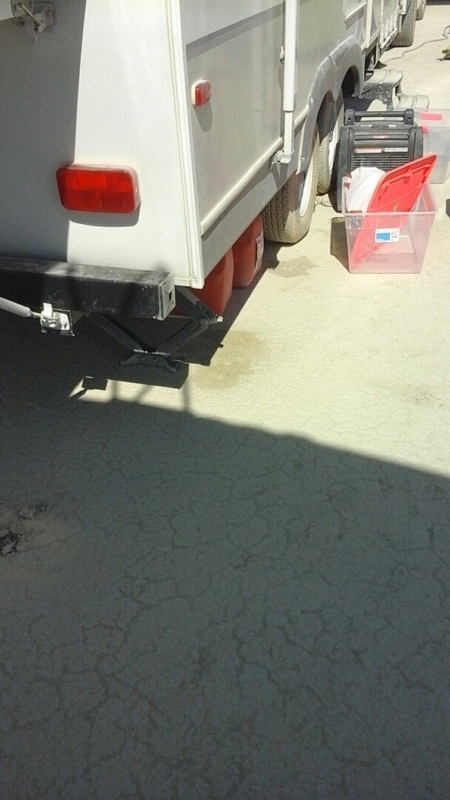
These cans are under a trailer (yikes!) and have no containment. It may seem counterintuitive to store fuel in the sun, but it’s safer to store it there, filled only to 80% capacity, than under a living container. Look — there’s an empty bin to put the fuel in once it’s moved!
4) Do not Have More Than 110 Gallons of Liquid Fuel Stored Within Your Camp!
This amount applies to fuel that is not in use and is regardless of the size of your camp. This doesn’t apply to fuel inside of or feeding a generator. Now that there are fuel deliveries on playa, there is no need to store copious amounts of fuel in your camp. Here are examples of doing it wrong:
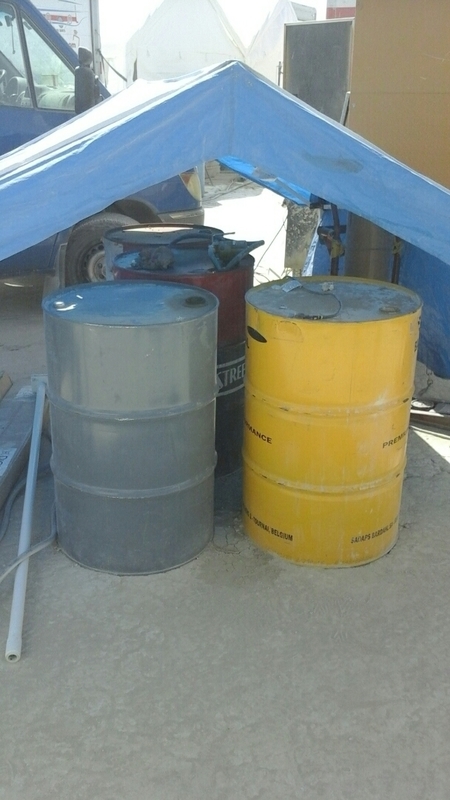
There are a few problems here: don’t build shade over fuel storage areas there is no secondary containment and there are four 55 gallon barrels (220 gallons of fuel) instead of the 110 gallons allowed and these drums are not grounded.
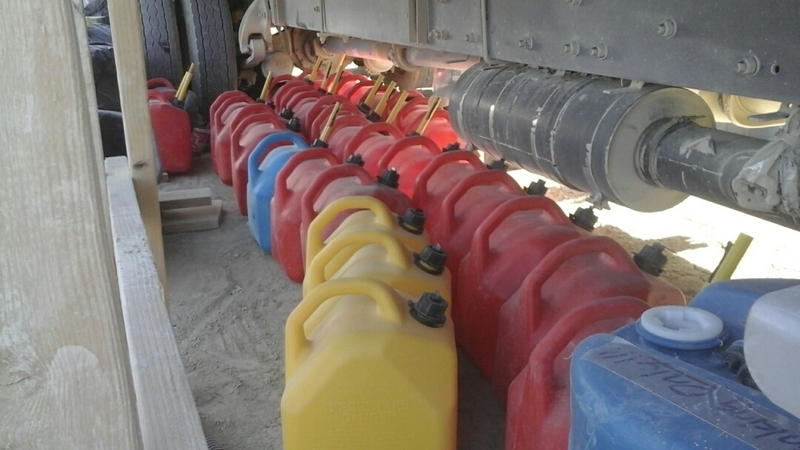
The same rule applies for small fuel containers — no more than 110 gallons of stored fuel in a camp. These containers need secondary containment as well, and need to be stored 10 ft away from non-fuel materials.
5) Protect Your Stored Fuel From Vehicle Collision!
Need we say more? DON’T STORE FUEL NEXT TO THE ROAD! Would you line your sidewalks and driveway at home with fuel? No, so don’t do it in BRC. Keep all stored fuel 10 ft away from any non-fuel items — cars, tents, bikes, and trailers.
Despite what we’ve shown you here, a LOT of Burners are doing it right. You can help us out. If you are cruising BRC and see fuel stored unsafely, find someone in the camp and (politely) let them know. You’ll be helping make their camp safer and might even save them a visit from the Compliance team or the BLM.
Proper fuel containment is a really important and relatively simple way to consider and reduce your impact on playa … take these steps and you’ll have it down, no problem.
[This post is part of our ‘Consider Your Impact’ series, where we’re telling stories that explore our community’s known and lesser-known effects on not just the Black Rock Desert itself, but the world around us as well. We hope it will raise awareness and inspire you to, well, consider your impact. Hence the name.]
Top photo: “The Great Train Wreck” by Collaborative Artisans, 2018. (Photo by Espressobuzzphoto)

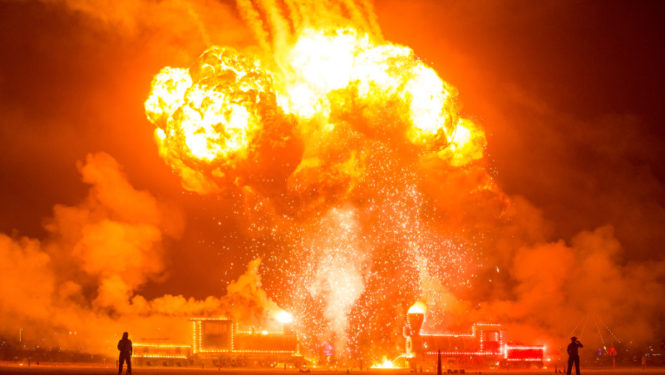
Great and exhaustive coverage, Scirpus! It couldn’t be clearer how to do fuel right, and what is so often and clearly done wrong. Leave no fuel trace training couldn’t be made simpler.
Report comment
Thank you on behalf of those of us that are Earth Guardians.
Report comment
Love love LOVE that our Great Train Wreck was used for dramatic effect for fire!
Report comment
Kudos for the photos of “dangerous storage”. I cringed looking at some of these. Fortunately we can purchase fuel at Hell Station now, eliminating the need to have such dangerous volumes of fuel in our camps.
Report comment
I do think you should have posted more ‘how to do it right’ pictures. I know how not to do it.
Report comment
Every year we light our camp on fire, it’s one of our rituals. We just let everything burn. We bring lots of gas and it all goes up real nice.
Thanks for the tips!
Report comment
BWAHAHAHAHAHAHA!!! You just made the start to my saturday a great one!!
Report comment
I’m curious about being allowed to leave fuel containers in trucks. We were considering leaving our fuel cans in our box truck (in adequate secondary containment) as it would be shaded and we could close the back to keep it secure, but I’m not sure if this practice is safe/condoned. Can you clarify/elaborate on this?
Report comment
Have you thought about gasoline fumes in an enclosed space? Kaboom!
Report comment
I’m told this isn’t good, but last year I was present when the inspectors came by and they said as long as our gas cans were in a secondary container they could stay in our truck.
Report comment
I think you need to consider what it means if you are calling the entire truck a fuel storage area, for example what is nearby (within 10 feet) of the truck. You need to maintain ten foot separation from the fuel location to anything else, for example another vehicle or a tent.
Report comment
I was cited by the BLM for improper fuel storage last year even though our fuel (4x 5g cans) was stored in catch basins underneath our truck.
The BLM officer said that the fuel had to be at least 20′ from any “ignition source” and our box truck was considered such.
This would seem to contradict some of the advice given here though I had no way of authenticating any of his claims at the time and fighting the citation would have been more expensive than the fine.
He claimed it was all about safety, but it sure felt like a hippie shake-down to me.
Report comment
Please go back and reread all the info under the photos of fuel stored in/near trucks. We want the Man to burn, not your camp!
Report comment
Nice article although I’d note the line about fuel deliveries is a little disingenuous: HELL is still supply constrained, particularly for gasoline, and they reasonably prioritize art and other projects that truly need it. They’re unable to deliver our camps requirements this year, which means we need to transport more fuel ourselves and store more in camp.
Report comment
What about propane? Our generator is duel fuel and I was thinking of just using propane this year to eliminate possibilty of spills. Will I need a 10 foot long hose to attach to generator? Will I still need containment (if they leak it is gas that will not spill).
Report comment
Given that large fire art uses propane containers directly on the playa with no secondary containment I’d be interested to hear if the rules are any different for camp storage of propane.
Report comment
This page has 3 sections: General Fuel Storage Requirements, Liquid Fuels (i.e. gas and diesel), and Compressed and Liquefied Fuel Gases (i.e. propane)
https://burningman.org/event/art-performance/fire-art-guidelines/fire-safety-agreements/fuel-and-hazardous-materials-storage/
I believe this means that the storage and LP sections apply, but not the liquid fuel section, which is the only one that includes containment.
So, my reading is you need secure storage 10′ from anything, the tanks need to be secured upright, but no secondary contaiment, transfer guidelines, or overall amount limits (other than no tanks > 99 gallons, with a standard 20lb propane tank being around 5 gallons).
Report comment
Comments are closed.